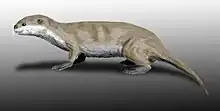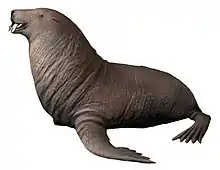| Pinnipedimorphs | |
|---|---|
 | |
| Artist reconstruction of Enaliarctos emlongi | |
| Scientific classification | |
| Domain: | Eukaryota |
| Kingdom: | Animalia |
| Phylum: | Chordata |
| Class: | Mammalia |
| Order: | Carnivora |
| Clade: | Pan-Pinnipedia |
| Clade: | Pinnipedimorpha Berta et al., 1989 |
| Subtaxa | |
| |
Pinnipedimorpha is a clade of arctoid carnivorans that is defined to include the last common ancestor of Phoca and Enaliarctos, and all descendants of that ancestor.[1] Scientists still debate on which lineage of arctoid carnivorans are the closest relatives to the pinnipedimorphs, being more closely related to musteloids.[2][3][4][5][6]
Below is an overall phylogeny of the taxa covered in the article followed after a composite tree in Berta et al. (2018)[1] and a total-evidence (combined molecular-morphological) dataset in Paterson et al. (2020):[7]
| |||||||||||||||||||||||||||||||||||||||||||||||||||||||||||||||||||||||||||||||
See also
References
- 1 2 Berta, A.; Churchill, M. & Boessenecker, R.W. (2018). "The Origin and Evolutionary Biology of Pinnipeds: Seals, Sea Lions, and Walruses". Annual Review of Earth and Planetary Sciences. 46: 203–228. Bibcode:2018AREPS..46..203B. doi:10.1146/annurev-earth-082517-010009.
- ↑ Lento, G. M.; Hickson, R. E.; Chambers, G. K.; Penny, D. (1995). "Use of spectral analysis to test hypotheses on the origin of pinnipeds". Molecular Biology and Evolution. 12 (1): 28–52. doi:10.1093/oxfordjournals.molbev.a040189. PMID 7877495.
- ↑ Hunt, R. M. Jr.; Barnes, L. G. (1994). "Basicranial evidence for ursid affinity of the oldest pinnipeds" (PDF). Proceedings of the San Diego Society of Natural History. 29: 57–67.
- ↑ Higdon, J. W.; Bininda-Emonds, O. R.; Beck, R. M.; Ferguson, S. H. (2007). "Phylogeny and divergence of the pinnipeds (Carnivora: Mammalia) assessed using a multigene dataset". BMC Evolutionary Biology. 7: 216. doi:10.1186/1471-2148-7-216. PMC 2245807. PMID 17996107.
- ↑ Sato, J. J.; Wolsan, M.; Suzuki, H.; Hosoda, T.; Yamaguchi, Y.; Hiyama, K.; Kobayashi, M.; Minami, S. (2006). "Evidence from nuclear DNA sequences sheds light on the phylogenetic relationships of Pinnipedia: Single origin with affinity to Musteloidea". Zoological Science. 23 (2): 125–46. doi:10.2108/zsj.23.125. hdl:2115/13508. PMID 16603806. S2CID 25795496.
- ↑ Flynn, J. J.; Finarelli, J. A.; Zehr, S.; Hsu, J.; Nedbal, M. A. (2005). "Molecular phylogeny of the Carnivora (Mammalia): Assessing the impact of increased sampling on resolving enigmatic relationships". Systematic Biology. 54 (2): 317–37. doi:10.1080/10635150590923326. PMID 16012099.
- ↑ Paterson, R. S.; Rybczynski, N.; Kohno, N.; Maddin, H. C. (2020). "Pinniped taxonomy: review of currently recognized species and subspecies, and evidence used for their description". Frontiers in Ecology and Evolution. 7 (457). doi:10.3389/fevo.2019.00457.
Further reading
- A. Berta, C. E. Ray, and A. R. Wyss. 1989. Skeleton of the oldest known pinniped, Enaliarctos mealsi. Science 244:60-62
This article is issued from Wikipedia. The text is licensed under Creative Commons - Attribution - Sharealike. Additional terms may apply for the media files.



